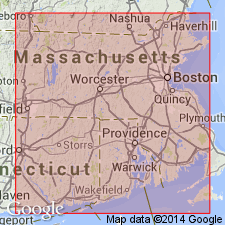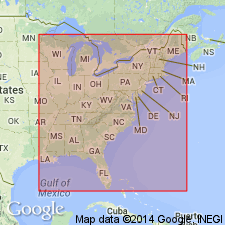
- Usage in publication:
-
- Price Neck Formation
- Modifications:
-
- Named
- Dominant lithology:
-
- Sandstone
- Siltstone
- Slate
- AAPG geologic province:
-
- New England province
Summary:
Price Neck Formation, first used by Murray and Skehan (1979: International Geological Correlation Program Project 27), was named by M.J. Webster (1983) in a Senior thesis at Boston College. Unit occurs in vicinity of Newport, southeastern RI. Composed predominantly of thin-bedded distal turbidites. Described as graded beds of sandstone, siltstone, and slate with bedded carbonate and volcanic conglomerate, mudflow deposits, ash-flow deposits, and lapilli tuffs. Slates are light green to dark purple where weathered. Sandstone beds are light gray to bluish white. Age is Late Proterozoic (800-700 Ma?) based on intrusion by Cliff Walk Granite (new name) at approximately 595 Ma. Estimated thickness is 900 m. . [This is first published formal definition of unit and is considered to be the formal proposal by the Geologic Names Unit.]
Source: GNU records (USGS DDS-6; Reston GNULEX).

- Usage in publication:
-
- Price Neck Formation*
- Modifications:
-
- Overview
- AAPG geologic province:
-
- New England province
Summary:
Used as Price Neck Formation in table 11 of report. Consists of agglomerate, tuff, siltstone, slate, and metarhyolite. Age is Late Proterozoic.
Source: GNU records (USGS DDS-6; Reston GNULEX).
For more information, please contact Nancy Stamm, Geologic Names Committee Secretary.
Asterisk (*) indicates published by U.S. Geological Survey authors.
"No current usage" (†) implies that a name has been abandoned or has fallen into disuse. Former usage and, if known, replacement name given in parentheses ( ).
Slash (/) indicates name conflicts with nomenclatural guidelines (CSN, 1933; ACSN, 1961, 1970; NACSN, 1983, 2005, 2021). May be explained within brackets ([ ]).

